B0041VYHGW EBOK (154 page)
Authors: David Bordwell,Kristin Thompson

- An introductory portion with the film’s title and director’s name and projectionists’ markings
- Quick, dynamic music with images of moving animals and vehicles on land
- A more mysterious, tense section stressing precariously balanced objects in air and water
- Frightening images of disaster and war interspersed with more lyrical, mysterious scenes
“Part of the creation of the sequence you’re thinking about happened during the process of collecting film. I snip out small parts of films and collect them on a larger reel. Sometimes when I tail-end one bit of the film onto another, I’ll find a relationship that I would have never thought about consciously—because it doesn’t create a logical continuity, or it doesn’t fit my concept of how to edit a film.”
— Bruce Conner, experimental filmmaker
In only 12 minutes,
A Movie
leads us through a range of emotionally charged ideas and qualities. It also creates a distinct developmental thread. In
segments 2
–
4
, many shots emphasize accidents or aggressive actions, and while some of these seem funny or trivial at first, they gradually accumulate and become more serious. By
segment 4
, a series of war scenes and natural disasters presents practically an apocalyptic vision.
A Movie
’s tone finally eases in its closing underwater scenes.
This segment does far more than give us the title and the filmmaker’s name, and for that reason, we have numbered it as the first segment rather than separating it off as a credits sequence. At first, we see blank black leader, over which the brisk opening of
The Pines of Rome
begins. This stresses the importance of the music in the film, since we hear it before seeing any images. Then the words “Bruce Conner” appear, remaining on the screen for many seconds. Because we do not need that much time to read the name, we may begin to sense that the film will playfully thwart our expectations.
After the name, we see more black leader, then white leader, then a quick flicker effect rapidly alternating two frames of the word “A” with a blank white leader, and finally the word “Movie.” The word “By” appears, with more white frames, then “Bruce Conner,” as before. Now a black leader appears, with markings that usually appear on the first portion of the film strip but that are seldom projected on the screen for the audience to see: splice cues, dots, and other signs. Then, suddenly, “End of Part Four” flashes on the screen.
We might think that Conner is simply playing with the graphic qualities of titles and leader marks, as Léger and Murphy did in segment 5 of
Ballet mécanique
with its dance of intertitles and zeros. But here Conner uses graphics with conventional meanings: leaders and credits usually signal the beginning, while “End of Part Four” implies we have already seen a considerable part of the film. Once again
A Movie
signals us that it will not be an ordinary film—not one in which the parts follow in logical order. We must expect odd juxtapositions. Moreover, the flicker and leader markings stress the physical qualities of the film medium itself. The title
A Movie
reinforces this reference to the medium, cueing us to watch this assemblage of shots
as
bits of film.
The opening continues with a countdown leader, beginning with “12” and flashing other numbers at one-second intervals—again, more signals to the projectionist, but seldom seen by the audience. Is
this
the beginning, then? But after “4,” we are startled to see the film’s first moving image: a “nudie” shot of a woman taking off her stockings. The shot is very worn, with lines and scratches, and we surmise that Conner scavenged it from an old stag film. Here
A Movie
helps us to focus our expectations by suggesting that it will involve more found footage of this type. After the nude shot, the countdown leader continues to “1,” then the words “The End” appear. Another joke: this is the end of the leader, not of the film. Yet even this is untrue, since more leader appears, with “Movie” backward, more projectionists’ signals, and a repeating number “1” that flickers in time to the music’s quick tempo, then goes to black.
Although the music runs continuously over the transition, in
segment 2
, we begin to see a very different kind of image. A series of 12 shots shows us mounted Indians sitting on a hill, then chasing a fleeing wagon train, with Hopa-long Cassidy recognizable as one of the cowboys. More old film footage follows, this time a clip suggesting a story situation that will continue from shot to shot: a fight between Indians and settlers. But Conner shows us this scene only to refer briefly to the conventional kind of movie he is
not
making
(
10.76
,
10.77
).
The association here seems clear enough; we move from horses to more horses, all in rapid motion. The next change, moving toward imagery of cavalry, confirms this association among horse-drawn vehicles.
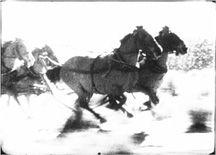
10.76 In
A Movie,
from a shot of galloping horses pulling a wagon, Conner cuts to …
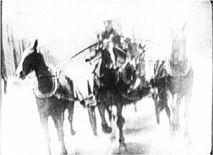
10.77 … similar horses, but now pulling a fire engine on a city street.
There follows a shaky shot of a charging elephant. Now we must stretch our associations to account for this: maybe the link is through a series of rapidly moving animals? This seems safe enough to assume, as we see two more shots of horses’ running legs. But the next shot shows a speeding locomotive’s wheels. We must generalize the terms of the association still further—the rapid motion of animals and vehicles on land. (The “on land” idea may not seem important at this point, but it will become significant in contrast to the later segments, which often emphasize air and water.) The next series of shots, repeating these motifs and introducing a military tank, seems to confirm this overall idea of rushing movement.
Conner’s editing creates the effect of one rushing mass of activity by a simple convention: common screen direction. The animals and vehicles move from left to right, or come directly at the camera, creating shots that cut together in traditional continuity (
10.76
,
10.77
). The effect is to suggest a colossal rush toward a single target. The impossibility of this juxtaposition is amusing, but it also suggests that humans, animals, and machines are caught up in an energetic planetary race—but toward what? The urgency of this sequence is heightened by graphic matches on objects hurtling out at the viewer
(
10.78
,
10.79
).
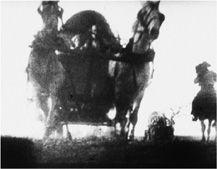
10.78 A graphic match in
A Movie
links wagon …
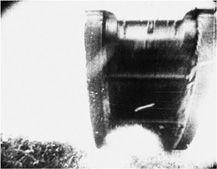
10.79 … and tank.
This sense of frantic activity continues into the later part of
segment 2
, which moves from the tank to a series of shots of race cars speeding around tracks. Since these shots initially confirm our expectations about moving animals and vehicles, they are less challenging to us—at first. Then one race car crashes, followed by two other similar crashes; and the segment ends with the long, spectacular fall of an old-fashioned car off a cliff. The sense of movement has become less funny and exhilarating, more uncontrolled and frightening. The tone of amusement has shifted toward one based on shock and horror in the face of so much devastation. Again, this effect is created by tight coordination of cutting, music, and movement in the frame. For instance, the frenzied buildup in the musical score accompanies the string of race car crashes. Blaring, dissonant phrases begin to punctuate the music at regular intervals, and Conner’s editing times each one to coincide with a car crash. The manic energy of the tumultuous race has turned reckless and self-destructive.
During the crashes, the music has built up to a frenzied climax, and it cuts off abruptly as a “The End” title flashes on the screen. This parody of the ending of a conventional film suggests that the crashes have resulted from all that rushing motion earlier in the segment. At this point, we might begin to sense that there has been an underlying tone of aggression and danger from the start: the attacking Indians, the cavalry, the charging elephant, the tank, and so on. This element will be intensified in
segments 3
and
4
.
More black leader continues the transition set up by the “The End” title, and there is a pause before the music of
segment 3
begins. (As at the film’s opening, it plays at first over the darkness.) But this time the music is slow, bleak, and slightly ominous. The “Movie” title and more black leader move us into a series of shots very different from those of
segment 2
. Two Polynesian women carry large, totemlike objects on their heads. Leader and a title interrupt once more, introducing a short series of shots of a large dirigible in flight
(
10.80
)
and of an acrobat couple performing on a small platform and tightrope high above a street
(
10.81
).
If the women and the dirigible are associated through balancing, the dirigible is linked to the acrobats not only by that but also by an emphasis on heights and danger. This portion of the segment ends with a shot of a small plane plunging downward through fleecy clouds, as if, having lost its balance, it is falling. Slow, sinister music has cued us how to react to these floating and falling objects; without the music, we might take them to be lyrical, but in context, they suggest a vague threat. This passage ends with more titles: “A,” “Movie,” “By,” and “Bruce Conner,” followed by black leader.
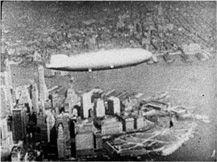
10.80
A Movie:
images of heights …